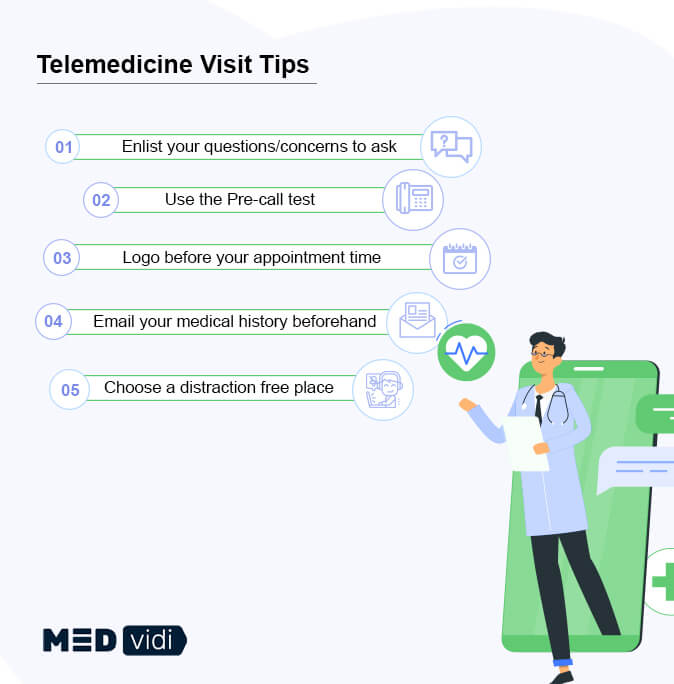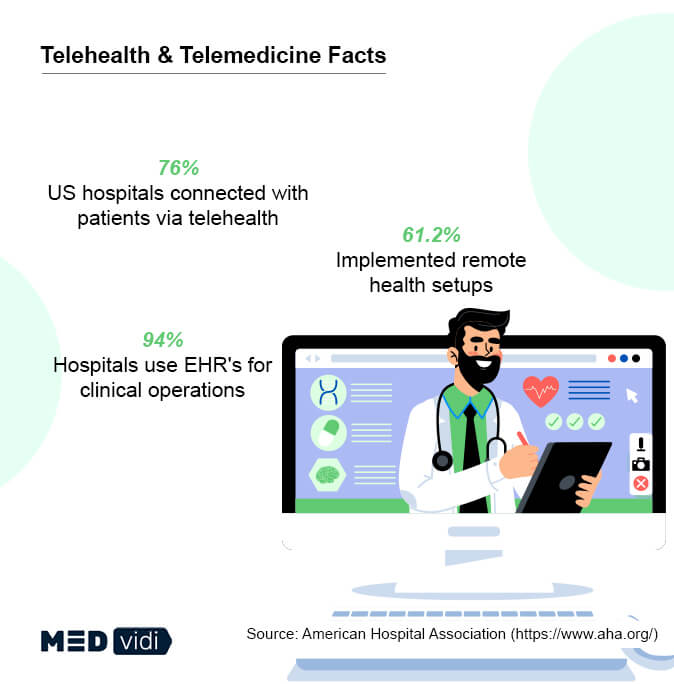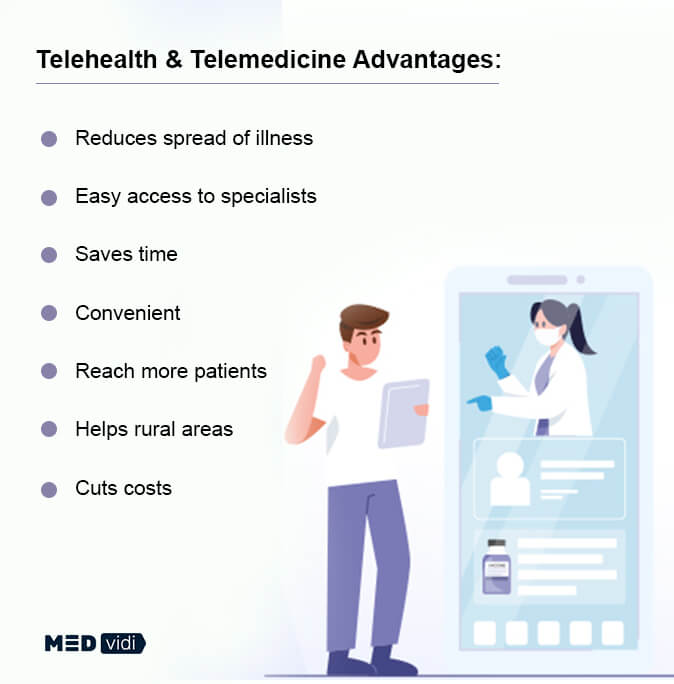In the past, people would need to travel to various healthcare centers and access healthcare workers for treatment and care. However, in the modern era, telemedicine and telehealth have changed the norm, and now health services can reach people from the comfort of their homes.
Now,
What are telemedicine and telehealth? Most people don’t know the exact telemedicine and telehealth differences and often use these terms interchangeably. Understanding the basics of telemedicine and telehealth is crucial considering the current telemedicine and telehealth trends. America’s health system is drastically shifting to the virtual care system. The adoption of telemedicine and telehealth is increasingly providing digital health solutions with improved patient care.
The professionals at Medvidi enable you to get the care you need from the safety of your home- Click below to schedule an appointment.
However, it is imperative to learn what is telehealth, telemedicine, and the difference between telehealth and telemedicine, along with various aspects related to both of these terms. This article has everything covered.
Let’s dive in.
What are Telemedicine and Telehealth?
Telemedicine and telehealth today are recognized as one of the most
What is Telemedicine?
Healthcare and technology have been connected since the invention of the telephone. After the advancement of the internet, physicians and health workers have been using video conferencing and many integrated medical devices for people in medically underserved areas. Most people now know what telemedicine is; for those new to this term, telemedicine simply means delivering medicine from a distance using communication technology. Telemedicine enables a person with health issues to receive medicine miles away without leaving their facility.
History of Telemedicine
Telemedicine has gained huge
Next,
What is Telehealth?
Telemedicine and telehealth go hand in hand in the medicine industry. Telehealth is the umbrella term, and telemedicine is a part of it. Unlike telemedicine, telehealth delivers all sorts of health care facilities to the patient. In simple practice, telehealth could be as straightforward as sharing a digital image through email.
Telehealth Vs. Telemedicine
People often confuse telemedicine and telehealth as the delivery of healthcare services to patients living in remote areas; this might apply to telemedicine, but for telehealth services, patients might be living near the hospital or in the city or good locality. There is a clear difference between telehealth and telemedicine, which is explained later in the next chapter.
So,
In such unfortunate situations where you can’t go out, get the care you need from the comfort of your home- Click below.
How Does Telehealth Work?
The technology has successfully integrated with healthcare and has enabled healthcare workers to conduct virtual examinations of patients from computers, iPhones, iPads, or androids.
Simple practice telehealth works with a two-way audio-video connection between the patient and the health professional. It includes consultations, examinations, treatments, primary and secondary surveys, and other purposes. So if a person requires any sort of health care, instead of going to the doctor and traveling away from your house, you can approach healthcare professionals via telemedicine and telehealth by opening up your computer or phone and requesting a virtual session.
Telehealth is an excellent resource from a patient’s perspective because you don’t have to go out and spend hours on the waiting lists. It is also a great relaxation from performing all the patient’s prerequisites, especially if you are bedridden, seriously ill, or simply can’t mobilize.
The doctors at Medvidi provide a comprehensive array of certified services online- Click below to book an appointment.

Telehealth Delivery Methods
There are three methods for providing healthcare services through telehealth:
- Synchronous – The synchronous method is also known as the ‘client interactive’ session. The provider and client are connected through real-time audio or video connection, replacing the traditional in-person experience with a virtual session.
- Asynchronous – Asynchronous is a type of delivery method in which a health professional sends information which could be a video recording or an audio message that the patient can see or access later. It is about providing therapy or healthcare service by using the telecommunication platform but without interactive sessions.
- Hybrid – Hybrid method incorporates both synchronous and asynchronous types. Not many healthcare providers would like to use this method because it would utilize a lot of time having live therapy sessions and then sending the recordings to both providers and the patients.
Health care professionals usually prefer the synchronous method because that has proven most beneficial for the clients. Most insurance companies also require clients to get synchronous telehealth services from the providers.
Telehealth Domains
Telehealth health has many domains, including
- Telehealth urgent care: In this domain, healthcare services are given for all the health issues which require immediate and serious attention. All you have to do is contact your health providers on the provided contact details, and they can arrange an urgent care virtual session for you.
- Telehealth for mental health: Telehealth mental health services are associated with providing virtual therapy sessions, consultations, counseling for untreated medical issues and addiction problems, and various other mental health-related services. There are many approaches used in telehealth for mental health, and one of the most commonly used nowadays is ‘telepsychiatry.’
Telepsychiatry works very well for the patients because they no longer have to travel for hours and wait to see their therapists. Mental health patients find telemedicine for mental health more convenient, feel more comfortable getting treated in their home environment, and are supported with ongoing care.
- Telehealth occupational therapy: Professionals provide evaluation, consultation, preventive and therapeutic services to clients in different locations. Telehealth occupational therapy enables people to develop various skills, helps incorporate assistive technology, and modify their lifestyles by recommending better and healthier options. Clients living in remote areas don’t have to deal with any delays in receiving care. The best part about telehealth occupational therapy is that the clients get full autonomy in scheduling their sessions and the overall cost is less expensive than traditional clinic visits.
- Telehealth pediatrics: Usually, telehealth deals with the communication between the provider and the client, but in telehealth pediatrics, it’s between the provider, the child, and their parents. The overall process is very similar to the clinical visits; there is a face-to-face interaction between clients and providers.
- Telehealth birth control: According to the latest trends, clients find it challenging to visit clinics, make appointments, and have sessions with their providers. Telehealth birth control domain provides help for patients with getting access to IUD consultancies, contraceptive prescriptions, giving information to clients, and doing screening and catering to all the health needs related to birth control.
Book a virtual visit with a licensed doctor for your health care needs and goals- Click the button below
Moving on to the next chapter.
Differences Between Telemedicine and Telehealth
Now that you have learned telemedicine and telehealth, the next important aspect is understanding the difference between telemedicine and telehealth. Undoubtedly, telemedicine and telehealth are interrelated, but there are still many differences between telemedicine and telehealth, making them two different entities.
So,

What Is the Difference Between Telemedicine and Telehealth?
According to the Health Resources and Services Administration, telehealth uses electronic information and telecommunication to provide long-distance clinical and non-clinical health services.
In contrast, telemedicine is associated with providing clients with clinical services only.
Avail the benefits of health services provided online- schedule your appointment for the care that’s always there.
The table below summarizes the major telemedicine and telehealth differences;
Telehealth Vs. Telemedicine: The Main Differences:
Telehealth Vs. Telemedicine Characteristics | Telehealth | Telemedicine |
|---|---|---|
Definition | Telehealth is a broader term associated with using communication technologies and information for providing clinical and non-clinical services. | Telemedicine is associated with using communication technologies by healthcare professionals to treat and diagnose patients in remote areas. |
Services | Include clinical services such as; consultation, examination, counseling, therapeutic services, etc. Include non-clinical services such as; medical education, administrative meetings, and provider training programs. | Telemedicine only includes clinical services such as; consultation, examination, counseling, therapeutic services, etc. |
Purpose and goals | Telehealth aims to provide adequate and high-quality patient-centered healthcare services, patient education services, and generating patient portals for people who have financial and physical barriers to getting quality healthcare support. | Telemedicine aims to offer online appointments, remote monitoring, screening, and therapeutic services to clients who cannot make clinical visits due to remote locations and mobility restrictions. |
Mode of delivery | Telehealth uses more advanced and updated technology to deliver clinical and non-clinical services. Telehealth is delivered through video communication, mega wireless and broadband IP connections, wearable medical devices, and complex internet and web-based networks. | Telemedicine uses smartphones, laptops, and mobile technology through various platforms such as video conferencing, audio calls, chats, and instant messages to support healthcare services such as; diagnosing, monitoring, screening, prescriptions, and treatment planning. |
Examples |
|
|
Telehealth Vs. Telemedicine: Comparison Summary
Both telemedicine and telehealth are related to each other. However, telehealth is a broader term that encompasses telemedicine along with virtual education and clinical health care resources. Telemedicine provides health care services for clinical use only and is not associated with patients’ portals or education. Telehealth, on the contrary, is a complex domain integrating ICTs (Information Communication Technology) into the system for the promotion of health resources, educational resources, and protection against health issues. Telemedicine is just a tiny component of telehealth. In general, both telemedicine and telehealth have a lot in common. They aim to promote quality health by enhancing the efficiency of the health care system for the clients and patients, hence why many aspects help connect telemedicine and telehealth, which are listed in the chapter below.
Landing on to the last chapter.
How Are Telemedicine and Telehealth Connected?
The modern era has stretched the healthcare system, especially
Moving on to,
Telehealth Vs. Telemedicine: Similarities
Although some components of telemedicine and telehealth may differ, there are many similarities because both share a more significant and broader goal of making remote healthcare services more efficient and accessible for every person despite location and other barriers.
Telemedicine and telehealth share the following similarities in general;
- Both use telecommunication for offering healthcare facilities to the clients
- Both use integrated technology and updated communication platforms
- The goal of both telemedicine and telehealth is to provide high-quality healthcare to patients
- Both aim to target people who want to access healthcare from a remote location
- Both the terms have a patient-focused approach
- Both aim to provide various clinical services
- Both aim to decrease the client interface by minimizing the contact
- Both are a subset of E-health
- Both desire to withdraw the need for an in-person visit
- There is a growing application of innovation in both domains
- Both telemedicine and telehealth are less expensive than traditional clinical visits
Apart from the similarities, both telemedicine and telehealth share some expected benefits, which are as follows:
Connect with medvidi.com today to get the best mental health help today from the comfort of your home. Click below to get started.
Benefits of Telemedicine and Telehealth
The evolution of telemedicine and telehealth means that healthcare resources can be provided more efficiently to the patients whenever they need it, how they need it and where they need it. Both the domains aim to extend the range of healthcare services to patients who can access them or simply want to avoid in-patient visits, and there are benefits for both the patients and the providers.

Patient-centered Benefits of Telemedicine and Telehealth
The following are the benefits related to the patients;
- Patients can get healthcare facilities in remote areas
- There is no time and place restriction
- This is the most convenient option for bedridden and mobility restricted patients to access healthcare regularly
- The overall cost is less expensive than the clinical visits
- The healthcare gap is greatly reduced for the patients
- Patients can have therapy sessions in their home environment with full autonomy of their schedules and comfort zone
Let our certified health professionals evaluate and diagnose your mental health symptoms and provide you the best telecare you need.
Next,
Provider-centered benefits of telemedicine and telehealth
The following are the benefits related to healthcare professionals/providers;
- Providers can access their patients more regularly
- They get a chance to educate themselves along with the patients
- Patient portals are an effective way of keeping and tracking clients’ progress data.
- Healthcare information is transferred in a more secure and sustainable way.
- The overall cost of infrastructure, clinical setting restrictions, and travel is removed.
- The healthcare barriers are lowered, more extensive research can be done, and more data through surveys can be recorded
Landing on the last part,
Ethical Challenges of Telemedicine and Telehealth
Clients throughout the United States want telemedicine and telehealth despite their location and time. The platforms provided by both domains are wide to provide various medical services. Considering that telemedicine and telehealth have countless benefits, the other side can not be ignored because there are some ethical challenges of telemedicine and telehealth that are arising with time. Healthcare providers are still nervous about the virtual healthcare idea because they don’t have clear guidelines necessary to practice digital healthcare in a compliant way. There has been advancement in the efficiency of both the domains, but by and large, the legal and ethical considerations remain the same:
- There is a lack of familiarity with the technology
- The verification of clients remains a gap
- The certification of therapists needs to be addressed
- Informed consent and security of the sensitive data must be protected
- There is a need to explain the logistics of the online delivery
- There are some state-specific laws and restrictions to be followed
The Bottom Line
Virtual care or telemedicine and telehealth are increasingly becoming the preferred choice of patients and providers in the United States of America. However, there are many differences and similarities when it comes to telehealth vs. telemedicine comparison. Despite the ethical challenges of telemedicine and telehealth, the general idea of both domains is being highly emphasized by the healthcare industry to fill the gap between people receiving optimum healthcare facilities in remote locations.
Our health professionals provide complex care, prescriptions, treatment plans, and various therapeutic approaches for many mental health problems through telemedicine and telehealth services. Connect with our certified health experts online at Telehealth Medvidi right now.












